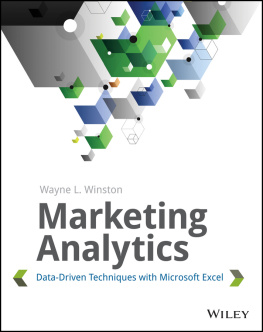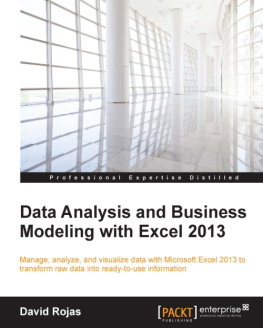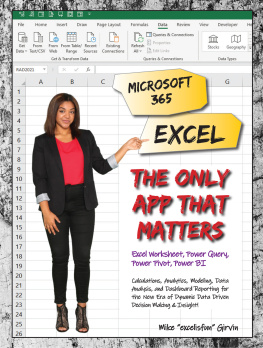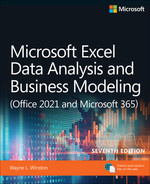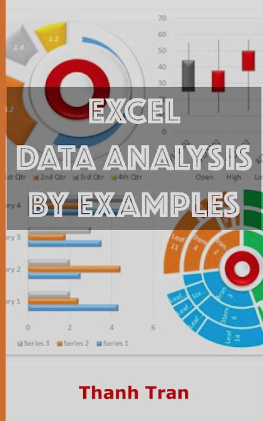Microsoft Excel 2010: Data Analysis and Business Modeling
Wayne L. Winston
Copyright 2011
All rights reserved. No part of the contents of this book may be reproduced or transmitted in any form or by any means without the written permission of the publisher.
Library of Congress Control Number: 2010934987
Microsoft Press books are available through booksellers and distributors worldwide. For further information about international editions, contact your local Microsoft Corporation office or contact Microsoft Press International directly at fax (425) 936-7329. Visit our Web site at .
Microsoft and the trademarks listed at http://www.microsoft.com/about/legal/en/us/IntellectualProperty/Trademarks/EN-US.aspx are trademarks of the Microsoft group of companies. All other marks are property of their respective owners.
The example companies, organizations, products, domain names, e-mail addresses, logos, people, places, and events depicted herein are fictitious. No association with any real company, organization, product, domain name, e-mail address, logo, person, place, or event is intended or should be inferred.
This book expresses the authors views and opinions. The information contained in this book is provided without any express, statutory, or implied warranties. Neither the authors, Microsoft Corporation, nor its resellers, or distributors will be held liable for any damages caused or alleged to be caused either directly or indirectly by this book.
Acquisitions Editor: Rosemary Caperton
Developmental Editor: Devon Musgrave
Project Editor: Rosemary Caperton
Editorial and Production: John Pierce and Waypoint Press
Technical Reviewer: Mitch Tulloch; Technical Review services provided by Content Master, a member of CM Group, Ltd.
Cover: Twist
Body Part No. X17-37446
Microsoft Press
Introduction
Whether you work for a Fortune 500 corporation, a small company, a government agency, or a not-for-profit organization, if youre reading this introduction the chances are you use Microsoft Excel in your daily work. Your job probably involves summarizing, reporting, and analyzing data. It might also involve building analytic models to help your employer increase profits, reduce costs, or manage operations more efficiently.
Since 1999, Ive taught thousands of analysts at organizations such as 3M, Bristol-Myers Squibb, Cisco Systems, Drugstore.com, eBay, Eli Lilly, Ford, General Electric, General Motors, Intel, Microsoft, NCR, Owens Corning, Pfizer, Proctor & Gamble, Tellabs, the U.S. Army, the U.S. Department of Defense, and Verizon how to use Excel more efficiently and productively in their jobs. Students have often told me that the tools and methods I teach in my classes have saved them hours of time each week and provided them with new and improved approaches for analyzing important business problems. Most of these classes used Excel 2003 or Excel 2007. With the added power of Excel 2010, you can be more productive than you ever dreamed! To paraphrase Alicia Silverstone in the movie Clueless , Excel 2007 is so five years ago.
Ive used the techniques described in this book in my own consulting practice to solve many business problems. For example, I use Excel to help the Dallas Mavericks NBA basketball team evaluate referees, players, and lineups. During the last 15 years I have also taught Excel business modeling and data analysis classes to MBA students at Indiana Universitys Kelley School of Business. (As proof of my teaching excellence, I have won MBA teaching awards for 25 consecutive years, and have won the schools overall MBA teaching award five times.) I would like to also note that 95 percent of MBA students at Indiana University take my spreadsheet modeling class even though it is an elective.
The book you have in your hands is an attempt to make these successful classes available to everyone. Here is why I think the book will help you learn how to use Excel more effectively:
The materials have been tested while teaching thousands of analysts working for Fortune 500 corporations and government agencies, including the U.S. Army.
Ive written the book as though I am talking to the reader. I hope this approach transfers the spirit of a successful classroom environment to the written page.
I teach by example, which makes concepts easier to master. These examples are constructed to have a real-world feel. Many of the examples are based on questions sent to me by employees of Fortune 500 corporations.
For the most part, I lead you through the approaches I take in Excel to set up and answer a wide range of data analysis and business questions. You can follow along with my explanations by referring to the sample worksheets that accompany each example. However, I have also included template files for the books examples on the companion website. If you want to, you can use these templates to work directly with Excel and complete each example on your own.
For the most part, the chapters are short and organized around a single concept. You should be able to master the content of most chapters with at most two hours of study. By looking at the questions that begin each chapter, youll gain an idea about the types of problems youll be able to solve after mastering a chapters topics.
In addition to learning about Excel formulas, you will learn some important math in a fairly painless fashion. For example, youll learn about statistics, forecasting, optimization models, Monte Carlo simulation, inventory modeling, and the mathematics of waiting in line. You will also learn about some recent developments in business thinking, such as real options, customer value, and mathematical pricing models.
At the end of each chapter, Ive provided a group of practice problems (over 600 in total) that you can work through on your own. These problems will help you master the information in each chapter. Answers to all problems are included in files on the books companion website. Many of these problems are based on actual problems faced by business analysts at Fortune 500 companies.
Most of all, learning should be fun. If you read this book, you will learn how to predict U.S. presidential elections, how to set football point spreads, how to determine the probability of winning at craps, and how to determine the probability of a specific team winning an NCAA tournament. These examples are interesting and fun, and they also teach you a lot about solving business problems with Excel.
To follow along with this book, you must have Excel 2010. Previous versions of this book can be used with Excel 2003 or Excel 2007.
What You Should Know Before Reading This Book
To follow the examples in this book you do not need to be an Excel guru. Basically, the two key actions you should know how to do are the following:
Enter a formula . You should know that formulas must begin with an equal sign (=). You should also know the basic mathematical operators. For example, you should know that an asterisk (*) is used for multiplication, a forward slash (/) is used for division, and the caret key (^) is used to raise a quantity to a power.
Work with cell references . You should know that when you copy a formula that contains a cell reference such as $A$4 (an absolute cell reference, which is created by including the dollar signs), the formula still refers to cell A4 in the cells you copy it to. When you copy a formula that contains a cell reference such as $A4 (a mixed cell address), the column remains fixed, but the row changes. Finally, when you copy a formula that contains a cell reference such as A4 (a relative cell reference), both the row and the column of the cells referenced in the formula change.


